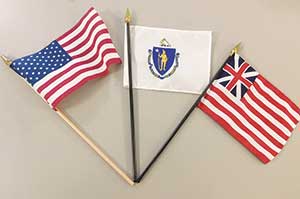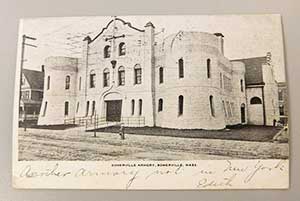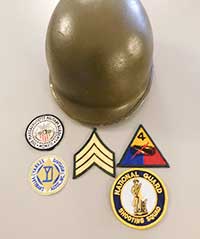 Eagle Feathers #120 – The Yanks Are Coming
Eagle Feathers #120 – The Yanks Are Coming
By Bob (Monty) Doherty
The Massachusetts National Guard is the nation’s oldest. It traces its roots back to 1636 when Governor John Winthrop and four regiments of volunteer militia protected the young Massachusetts Bay Colony.
The best place to learn and appreciate its history would be to visit the Hall of Flags at the State House in Boston. On display you will find the flags that their forebears fought and served under to the present day. These ensigns record the strife from colonial times when every man and boy age 16 to 60 were required to serve in the militia to today’s citizen soldiers who endured multiple deployments overseas. These streamers remind us of the sacrifices that were made for us from the Colonial Wars, the Revolutionary War, the War of 1812, the Mexican War, the Civil War, and the Spanish American War.

Like many arsenals and magazines throughout New England, the Somerville Armory on Highland Avenue was used as such for over a century. It was built in 1903 and sold by the state in 2004. Somerville and the local volunteer militia, the State Guard, the Massachusetts National Guard, and the Air Guard found home for training there.
 In 1916 during the Mexican Revolution, the soldiers left here to guard the United States border against the attacks of General Francisco ”Pancho” Villa’s Mexican bandits. On their return in 1917, one hundred years ago this year, America entered World War I, mistakenly named “the war to end all wars.” The now veteran guardsmen were activated into the newly formed 26th Infantry Division. It was titled The Yankee Division because of its six–state New England location. The Division was the first complete American Division to arrive in World War I France and spent more time in combat than any other. As part of this Division, Somerville’s Private George Dilboy won the Congressional Medal of Honor.
In 1916 during the Mexican Revolution, the soldiers left here to guard the United States border against the attacks of General Francisco ”Pancho” Villa’s Mexican bandits. On their return in 1917, one hundred years ago this year, America entered World War I, mistakenly named “the war to end all wars.” The now veteran guardsmen were activated into the newly formed 26th Infantry Division. It was titled The Yankee Division because of its six–state New England location. The Division was the first complete American Division to arrive in World War I France and spent more time in combat than any other. As part of this Division, Somerville’s Private George Dilboy won the Congressional Medal of Honor.

Twenty years later, the world found Europe at war again. The Yankee Division was reactivated in 1940, a year before the attack on Pearl Harbor. Her troops did Atlantic coastal watch and trained until we entered the war. At that time, half of the 26th was sent immediately to fight in the Pacific, becoming the Americal Division; and the remainder later sailed to Europe. The over one hundred ship convoy was the largest to sail from the United States. As the ships slipped out of New York’s rainy harbor, troops heard the impassioned sound of Kate Smith standing on the dark pier singing “God Bless America.” Many of them would not return.

Almost half of the 600 men in the 5th Ranger Battalion on Omaha Beach were Yankee Division troops. When in France as part of General George S. Patton’s Third Army, the Division fought in the Battle of the Bulge and was instrumental in relieving the trapped American 101st Airborne Division’s troops at Bastogne. Led by Patton, they fought on through six countries including Germany and Austria where they liberated the Gusen Concentration Camps.

The General Edwards Bridge in Lynn and Camp Edwards on Cape Cod honor the Yankee Division’s first leader, General Clarence Edwards.
Somerville honors many of her sons who lost their lives fighting in the Yankee Division. These include Conway Park, Foss Park, Trum Field, Dilboy Field, Wilson Square, Ryan Road, and many others.

Massachusetts honored some of the greatest generation’s soldiers by naming its first super highway, Route 128, The Yankee Division Highway.
















Reader Comments